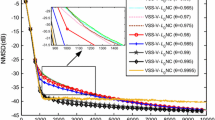Abstract
The convergence, robustness and steady-state performance are three key points to consider when evaluating variable step-size algorithms. The theoretical depth of the algorithm, the stability of step-size and the performance analysis all affect these key points. Based on these points, a novel variable step-size algorithm was derived from a steady-state mixed error cost function. The algorithm was developed according to basic theoretical formulas and provides a certain level of theoretical depth. In addition, to balance the relation between convergence and robustness, an improved restricted method that uses different restricted parameters at different stages was combined with the step-size algorithm. This method maintains the convergence speed while reducing fluctuations. Furthermore, the proposed algorithm eliminates numerous parameters and approaches the optimal step-size without increasing the computational burden. Weight misalignment, stability and complexity performance analyses are also provided. According to the experimental results and analyses, the proposed algorithm has a good performance.




Similar content being viewed by others
Data availability statement
The datasets generated during and/or analysed during the current study are available from the corresponding author on reasonable request.
References
J. Benesty, H. Rey, L.R. Vega, S. Tressens, A nonparametric VSS NLMS algorithm. IEEE Signal Process. Lett. 13(10), 581–584 (2006)
X. Chen, J. Ni, Variable step-size weighted zero-attracting sign algorithm. Signal Process. 172, 107542.1-107542.5 (2020)
T. Fan, Y. Lin, A variable step-size strategy based on error function for sparse system identification. Circuits Syst. Signal Process 36, 1301–1310 (2017)
Y. Fang, X. Zhu, Z. Gao et al., New feedforward filtered-x least mean square algorithm with variable step size for active vibration control. J. Low Freq. Noise Vibr. Active Control 38(1), 187–198 (2019)
S. Haykin, Adaptive Filter Theory, Pearson (2015)
H.C. Huang, J. Lee, A new variable step-size NLMS algorithm and its performance analysis. IEEE Trans. Signal Process. 60(4), 2055–2060 (2012)
B. Jalal, X. Yang, Q. Liu, Fast and robust variable step-size LMS algorithm for adaptive beamforming. IEEE Antennas Wireless Propagat. Lett. 19(7), 1206–1210 (2020)
J.H. Jeon, S.W. Nam, Robust variable step-size affine projection SAF algorithm against impulsive noises. IEICE Trans. Fundament. Electr. Commun. Comput. 101(5), 844–847 (2018)
M. Li, L. Li, H.M. Tai, Variable step size LMS algorithm based on function control. Circuits Syst. Signal Process. 32(6), 3121–3130 (2013)
M.O.B. Saeed, LMS-Based variable step-size algorithms: A unified analysis approach. Arabian J. Sci. Eng. 42(7), 2809–2816 (2017)
M.O.B. Saeed, S.A. Pasha, A. Zerguine, A variable step-size incremental LMS solution for low SNR applications. Signal Process. 178, 107730.1-107730.8 (2021)
Y. Song, Y. Ren, X. Liu et al., A nonparametric variable step-size subband adaptive filtering algorithm for acoustic echo cancellation. Int. J. Agric. Biol. Eng. 13(3), 168–173 (2020)
Z. Yan, F. Yang, J. Yang, Optimum step-size control for a variable step-size stereo acoustic echo canceller in the frequency domain. Speech Commun. 124(2), 21–27 (2020)
K. Yin, H. Zhao, A variable step-size shrinkage set-membership affine projection algorithm for noisy input. Circuits Syst. Signal Process. 38, 455–469 (2019)
Z. Zheng, Z. Liu, L. Lu, Bias-compensated robust set-membership NLMS algorithm against impulsive noises and noisy inputs. Electr.. Lett. 53(16), 1100–1102 (2017)
Acknowledgements
This letter was funded by projects including the Scientific Research Foundation for the Highlevel Personnel of Nanjing Institute of Technology (grant: YKJ2019106 and YKJ202042) and the Natural Science Foundation of the Jiangsu Higher Education Institutions of China (grant: 20KJD510002).
Author information
Authors and Affiliations
Corresponding author
Additional information
Publisher's Note
Springer Nature remains neutral with regard to jurisdictional claims in published maps and institutional affiliations.
Rights and permissions
About this article
Cite this article
Han, Y., Li, Y. Mixed Error Variable Step-Size Algorithm with Constrained Function. Circuits Syst Signal Process 41, 5307–5318 (2022). https://doi.org/10.1007/s00034-022-02015-5
Received:
Revised:
Accepted:
Published:
Issue Date:
DOI: https://doi.org/10.1007/s00034-022-02015-5




